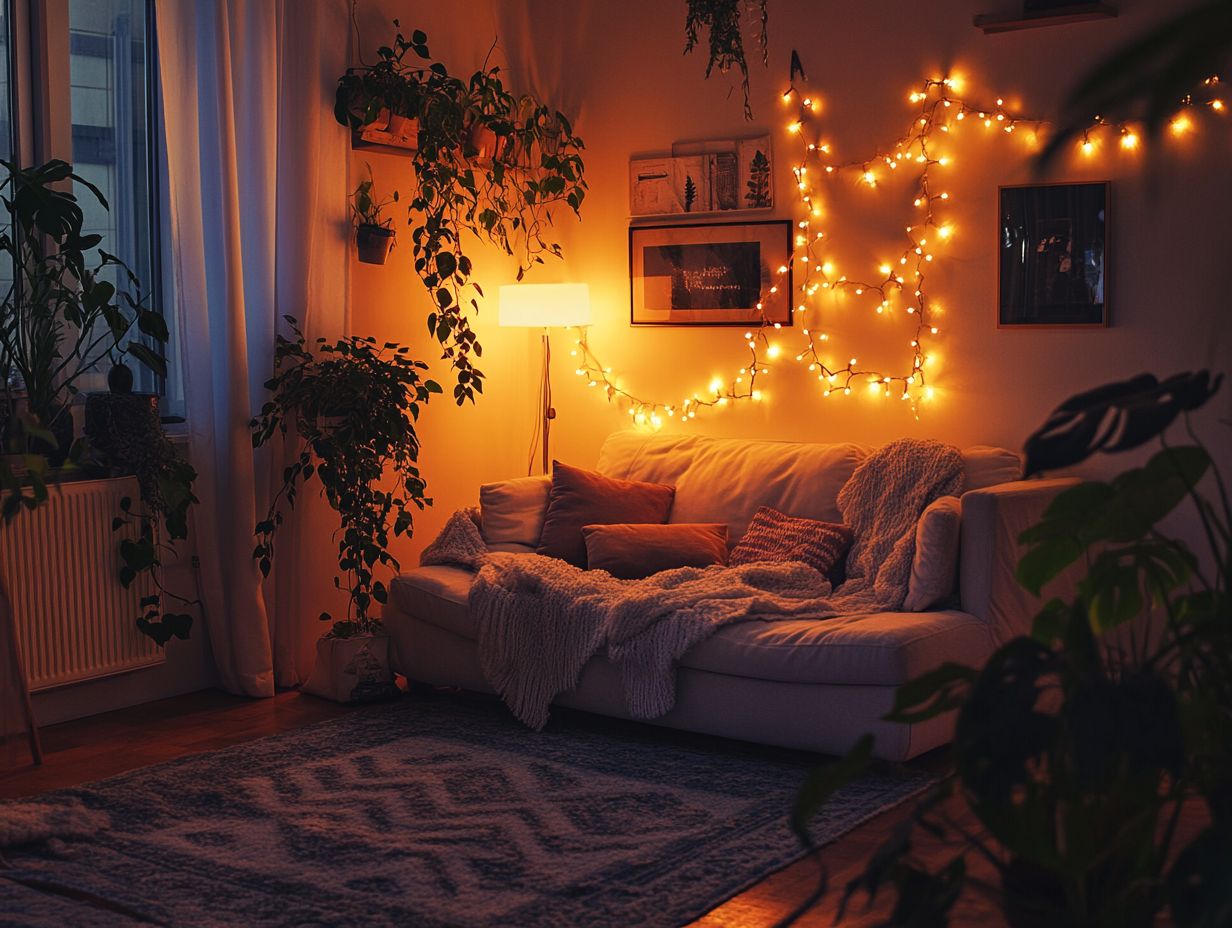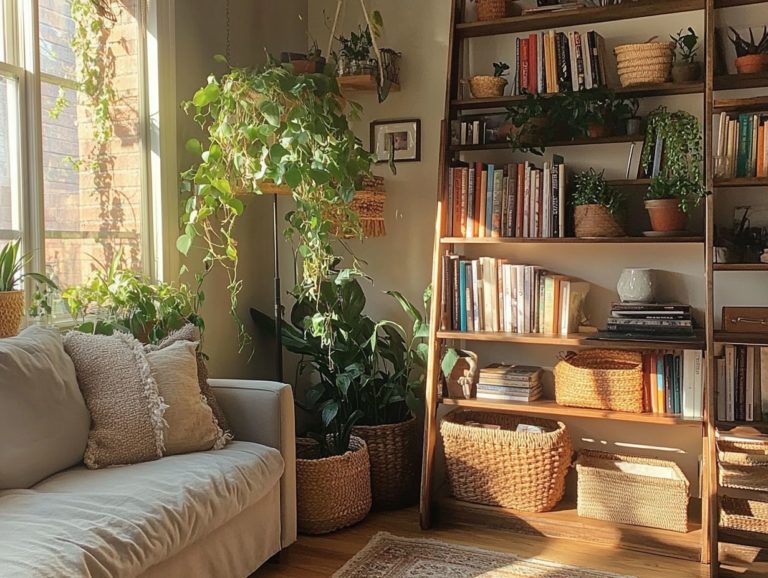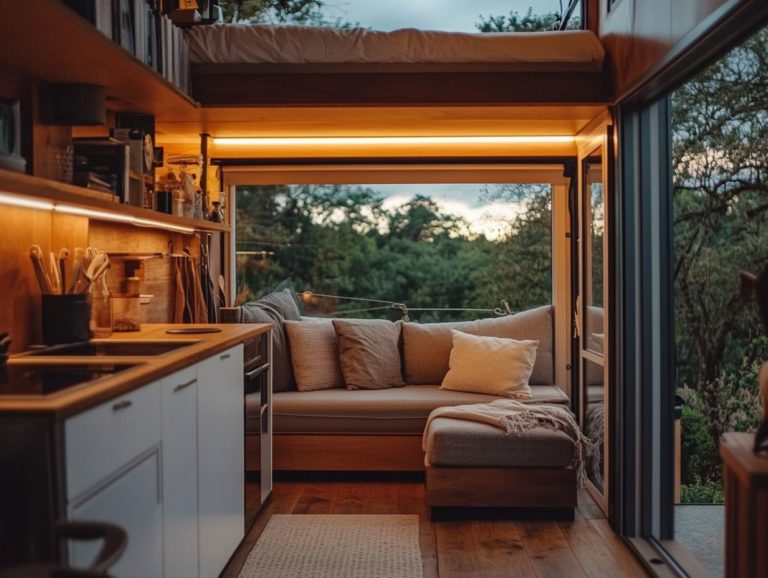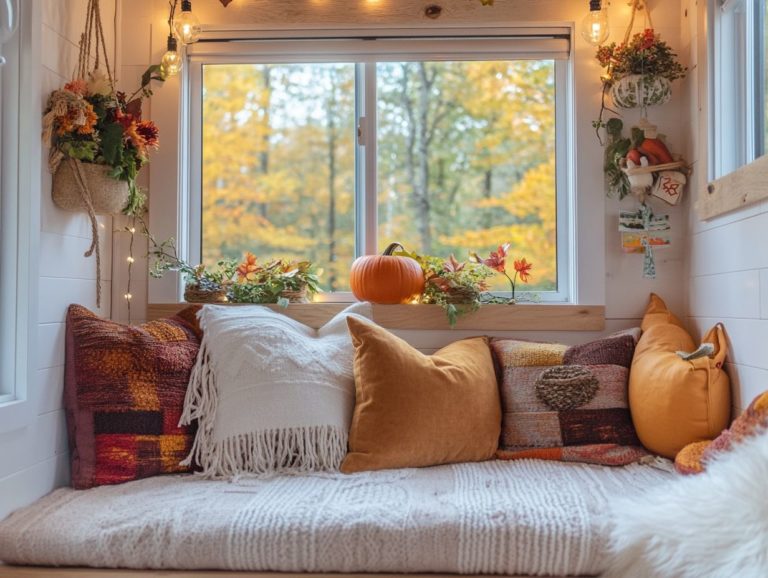Choosing the Right Lighting for Tiny Spaces
Finding the right indoor lighting for your small space can truly elevate its ambiance and functionality.
Consider important points such as the size and layout of your area, along with its intended purpose. Different types of lighting task lighting for specific activities, ambient lighting for general mood, and accent lighting to highlight features can significantly enhance the overall atmosphere.
You can also find practical tips for maximizing natural light and optimizing small, multi-purpose, and outdoor spaces.
Light up your small space with style, and see it transform!
Contents
- Key Takeaways:
- Factors to Consider When Lighting Tiny Spaces
- Lighting Options for Small Areas
- Lighting Tips for Different Types of Tiny Spaces
- Maximizing Natural Light in Tiny Spaces
- Frequently Asked Questions
- 1. How important is lighting in tiny spaces?
- 2. What are the key factors to consider when choosing the right lighting for tiny spaces?
- 3. What type of lighting is best for tiny spaces?
- 4. Should I use bright or dim lighting in a tiny space?
- 5. How can I make the most out of natural lighting in a tiny space?
- 6. Are there any specific lighting fixtures that work best in tiny spaces?
Key Takeaways:

- Consider the size and function of the tiny space when choosing lighting options.
- Utilize a mix of task, ambient, and accent lighting to create a well-lit and functional space.
- Maximize natural light through strategic placement and use of reflective surfaces and window treatments.
Factors to Consider When Lighting Tiny Spaces
When it comes to indoor lighting for compact spaces, consider important aspects to create a warm atmosphere and optimize the area. You need to understand the specific dimensions and layout of your small space, as well as maximizing natural light that shifts throughout the day; these elements will greatly influence your lighting design.
Working with interior designers can enhance both the look and functionality of your environment. They can help you select the perfect lighting options for every corner that needs illumination.
Size and Layout of Space
The size and layout of your small space are key in determining which lighting solutions will enhance aesthetics and functionality. Consider your room’s dimensions: choosing between wall sconces and flush mount lighting can greatly impact the ambiance.
Wall sconces shine in narrow corridors or cozy living areas where furniture limits overhead options. Flush mount fixtures, on the other hand, provide a sleek look in rooms with lower ceilings while keeping the area feeling open.
In larger rooms, a stylish mix of ceiling lights and layered lighting can help define spaces, creating the illusion of a more expansive environment. Understanding how room dimensions affect your lighting choices leads to designs that are both practical and visually appealing.
Function and Purpose of Space
Knowing the function and purpose of a space is essential when selecting types of lighting. Whether you need task lighting for work areas or general lighting for relaxation zones, making the right choice can elevate your environment.
In bedrooms, soft lighting is vital for creating a calming atmosphere. Soft ambient lighting fosters rest, while bedside task lighting is perfect for reading. In bathrooms, a blend of both is ideal task lighting brightens mirrors for grooming, while ambient lighting creates a soothing environment.
A well-structured lighting guide can help harmonize these elements, ensuring each corner of your home is perfectly lit for its purpose, enhancing both functionality and comfort.
Lighting Options for Small Areas
In small spaces, you can elevate both function and aesthetics by incorporating various types of lighting task lighting for focused activities, ambient lighting for overall illumination, and accent lighting to highlight features.
This layered approach creates a harmonious effect that transforms your environment.
Task Lighting

Task lighting is essential for small spaces, providing focused illumination for activities like reading, cooking, or working. It ensures functionality while keeping clutter at bay.
In compact areas, solutions like pendant lighting elevate both style and efficiency. These fixtures hang gracefully above kitchen islands or desks, offering bright light exactly where you need it most.
Adjustable lamps are also important. They allow you to pivot the light direction based on your task requirements, maximizing surface usage.
By harmonizing these lighting features with thoughtful furniture arrangements, you can cultivate an inviting atmosphere while maintaining an organized appearance. It s all about striking the perfect balance between aesthetics and practicality to optimize the available space.
Ambient Lighting
Ambient lighting serves as the foundation of light in smaller spaces. It uses ceiling lights and various fixtures to create a cozy atmosphere that enriches visual intrigue.
This type of lighting is important for creating the character of a room. It allows even the most compact areas to feel inviting and warm.
Consider solutions like flush mount fixtures and soft LED lights. They provide ample illumination without overwhelming the senses. Thoughtfully placing these light sources creates a balanced glow that highlights design elements while preserving a sense of openness.
The right ambient lighting can cleverly disguise awkward layouts and reduce shadows, transforming your space into a harmonious and aesthetically pleasing environment.
Accent Lighting
Accent lighting is a fantastic way to showcase design elements in small spaces. It employs decorative lighting, chic fixtures, and even color-changing lights to craft striking visual focal points.
Mount wall sconces beside artwork or mirrors to draw the eye and add depth to the room. Direct spotlights toward shelves adorned with decorative items or plants to enhance the overall ambiance.
The dance of light and shadow elevates visual appeal and creates inviting nooks within the compact area. By carefully positioning these light sources, you can transform what seems like a cramped space into a well-lit sanctuary that feels both expansive and cozy.
Lighting Tips for Different Types of Tiny Spaces
By incorporating tailored lighting strategies for various tiny spaces—whether they be small rooms, multi-purpose areas, or outdoor settings—you can dramatically elevate both functionality and comfort, as highlighted in the impact of lighting on tiny house decor.
Small Rooms
In small rooms, employing cozy and layered lighting techniques can transform the space into an inviting haven while ensuring effective illumination.
Thoughtfully positioning mirrors to reflect both natural and artificial light amplifies brightness and gives the illusion of a larger area. Arranging your furniture to optimize the flow of light enhances the overall ambiance significantly.
For instance, selecting reflective surfaces for tables or choosing lighter-colored upholstery fosters a more airy atmosphere. Incorporating a variety of light sources, such as wall sconces or floor lamps, enriches the environment even further, making small rooms feel warm and open, inviting you to relish every corner.
Start transforming your tiny spaces today with these lighting tips and see the difference for yourself!
Multi-Purpose Spaces

Creating effective lighting for multi-purpose spaces calls for flexible solutions. These solutions allow you to combine different types of lighting that accommodate various activities throughout the day.
By embracing smart lighting technologies, you can effortlessly adjust brightness and color temperature to match specific tasks. This could be reading, working, or entertaining guests. For instance, dimmable LED fixtures offer versatility to shift from bright task lighting for focused activities to softer ambient lighting for unwinding.
This adaptability elevates the functionality of your space while promoting energy efficiency. You can easily dim or turn off unnecessary lights when they re not needed. Implementing smart controls, such as mobile apps or voice-activated systems, simplifies this process, allowing you to make seamless adjustments that cater precisely to your needs.
Outdoor Spaces
Decorative lighting in your outdoor spaces brings warmth and charm to your gatherings. Utilize stylish fixtures and effective illumination techniques.
Host lively gatherings or enjoy serene dinners outdoors. Outdoor lighting can elevate your experience in ways you might not have imagined. Options like string lights infuse a whimsical charm, creating a magical canopy overhead. Decorative lanterns add both versatility and elegance. These solutions provide a cozy glow that enhances ambiance while ensuring safety and visibility for your guests as they navigate pathways or decks.
With the perfect blend of fixtures, you can craft a welcome environment that seamlessly merges comfort with functionality. Every outdoor moment becomes truly special.
Maximizing Natural Light in Tiny Spaces
To maximize natural light in small spaces, prioritize creating an airy, open ambiance. Achieve this through carefully selected window treatments and strategic use of reflective surfaces.
Window Treatments and Placement
The right window treatments and their placement can dramatically impact how natural light enters your space. It is crucial to select options that facilitate optimal light management.
Consider sheer curtains. They elegantly diffuse sunlight, casting a soft glow that elevates the warmth of any room. Sheer curtains provide an airy feel without completely sacrificing your privacy.
Alternatively, blinds wooden, faux wood, or aluminum afford adjustable control over light levels. By tilting the slats, you can customize brightness to suit different times of the day, while maintaining a sophisticated appearance.
When you combine these treatments, you create a layered effect that blends functionality with style. This allows for a captivating interplay between light and design.
Reflective Surfaces
Incorporating reflective surfaces like mirrors can amplify the effect of natural light. This makes small spaces feel larger and more inviting through skillful illumination techniques.
By strategically placing mirrors where sunlight streams in, you can distribute light evenly throughout the room. This creates a sense of depth that defies the limitations of confined spaces. For example, positioning a large mirror opposite a window effectively doubles the natural light bouncing around, transforming a dim corner into a bright nook.
Additionally, polished surfaces on furniture or glass decor further enhance this luminous effect. This thoughtful arrangement optimizes your available space while cultivating a welcome atmosphere that encourages relaxation and comfort.
Frequently Asked Questions

1. How important is lighting in tiny spaces?
Lighting is vital in tiny spaces as it creates the illusion of more space and enhances ambiance.
2. What are the key factors to consider when choosing the right lighting for tiny spaces?
The key factors include the size and layout of the space, natural light sources, the purpose of the space, and the desired atmosphere.
3. What type of lighting is best for tiny spaces?
Task lighting is ideal for tiny spaces. Options like track or recessed lights provide focused light where you need it, and understanding how to choose proper lighting for small spaces can enhance both functionality and ambiance.
Ambient lighting, such as wall sconces or string lights, helps create a warm and inviting atmosphere. Additionally, choosing the right curtains for tiny spaces can further transform your cozy oasis!
4. Should I use bright or dim lighting in a tiny space?
It depends on the purpose of the space. Bright lighting is recommended for areas like kitchens or study areas to increase productivity.
In contrast, dimmer and warmer lighting in living areas creates a cozy and relaxed atmosphere.
5. How can I make the most out of natural lighting in a tiny space?
Incorporating mirrors, light-colored walls and furniture, and sheer curtains can help maximize natural light in a tiny space.
Avoiding bulky or dark-colored furniture reflects natural light and makes the space feel larger.
6. Are there any specific lighting fixtures that work best in tiny spaces?
Flush mount or semi-flush mount fixtures are ideal for tiny spaces. These low-profile fixtures do not take up much room and keep your space looking open.
Utilizing multi-functional lighting fixtures, like a ceiling fan with a built-in light, saves space and adds functionality to the room.






